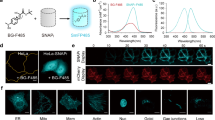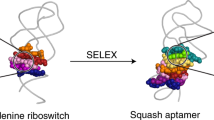Abstract
GFP and its derivatives revolutionized the study of proteins. Spinach is a recently reported in vitro–evolved RNA mimic of GFP, which as genetically encoded fusions makes possible live-cell, real-time imaging of biological RNAs without resorting to large RNA-binding protein–GFP fusions. To elucidate the molecular basis of Spinach fluorescence, we solved the cocrystal structure of Spinach bound to its cognate exogenous chromophore, showing that Spinach activates the small molecule by immobilizing it between a base triple, a G-quadruplex and an unpaired G. Mutational and NMR analyses indicate that the G-quadruplex is essential for Spinach fluorescence, is also present in other fluorogenic RNAs and may represent a general strategy for RNAs to induce fluorescence of chromophores. The structure guided the design of a miniaturized 'Baby Spinach', and it provides a foundation for structure-driven design and tuning of fluorescent RNAs.
This is a preview of subscription content, access via your institution
Access options
Subscribe to this journal
Receive 12 print issues and online access
$189.00 per year
only $15.75 per issue
Buy this article
- Purchase on Springer Link
- Instant access to full article PDF
Prices may be subject to local taxes which are calculated during checkout




Similar content being viewed by others
References
Tsien, R.Y. The green fluorescent protein. Annu. Rev. Biochem. 67, 509–544 (1998).
Day, R.N. & Davidson, M.W. (eds.) The Fluorescent Protein Revolution (CRC Press, Boca Raton, Florida, USA, 2014).
Chalfie, M., Tu, Y., Euskirchen, G., Ward, W. & Prasher, D. Green fluorescent protein as a marker for gene expression. Science 263, 802–805 (1994).
Ormö, M. et al. Crystal structure of the Aequorea victoria green fluorescent protein. Science 273, 1392–1395 (1996).
Yang, F., Moss, L.G. & Phillips, G.N. The molecular structure of green fluorescent protein. Nat. Biotechnol. 14, 1246–1251 (1996).
Paige, J.S., Wu, K.Y. & Jaffrey, S.R. RNA mimics of green fluorescent protein. Science 333, 642–646 (2011).
Shimomura, O. Structure of the chromophore of Aequorea green fluorescent protein. FEBS Lett. 104, 220–222 (1979).
Strack, R.L., Disney, M.D. & Jaffrey, S.R. A superfolding Spinach2 reveals the dynamic nature of trinucleotide repeat–containing RNA. Nat. Methods 10, 1219–1224 (2013).
Babendure, J.R., Adams, S.R. & Tsien, R.Y. Aptamers switch on fluorescence of triphenylmethane dyes. J. Am. Chem. Soc. 125, 14716–14717 (2003).
Constantin, T.P. et al. Synthesis of new fluorogenic cyanine dyes and incorporation into RNA fluoromodules. Org. Lett. 10, 1561–1564 (2008).
Pothoulakis, G., Ceroni, F., Reeve, B. & Ellis, T. The Spinach RNA aptamer as a characterization tool for synthetic biology. ACS Synth. Biol. 3, 182–187 (2014).
Strack, R.L., Song, W. & Jaffrey, S.R. Using Spinach-based sensors for fluorescence imaging of intracellular metabolites and proteins in living bacteria. Nat. Protoc. 9, 146–155 (2014).
Strack, R.L. & Jaffrey, S.R. New approaches for sensing metabolites and proteins in live cells using RNA. Curr. Opin. Chem. Biol. 17, 651–655 (2013).
Paige, J.S., Nguyen-Duc, T., Song, W. & Jaffrey, S.R. Fluorescence imaging of cellular metabolites with RNA. Science 335, 1194 (2012).
Kellenberger, C.A., Wilson, S.C., Sales-Lee, J. & Hammond, M.C. RNA-based fluorescent biosensors for live cell imaging of second messengers cyclic di-GMP and dyclic AMP-GMP. J. Am. Chem. Soc. 135, 4906–4909 (2013).
Nakayama, S., Luo, Y., Zhou, J., Dayie, T.K. & Sintim, H.O. Nanomolar fluorescent detection of c-di-GMP using a modular aptamer strategy. Chem. Commun. (Camb.) 48, 9059–9061 (2012).
Huang, H. et al. A G-quadruplex–containing RNA activates fluorescence in a GFP-like fluorophore. Nat. Chem. Biol. doi:10.1038/nchembio.1561 (22 June 2014)
Neidle, S. & Balasubramanian, S. (eds.) Quadruplex Nucleic Acids (RSC Publishing, Cambridge, 2006).
Gellert, M., Lipsett, M.N. & Davies, D.R. Helix formation by guanylic acid. Proc. Natl. Acad. Sci. USA 48, 2013–2018 (1962).
Paul, B.K. & Guchhait, N. Looking at the green fluorescent protein (GFP) chromophore from a different perspective: a computational insight. Spectrochim. Acta A Mol. Biomol. Spectrosc. 103, 295–303 (2013).
Auffinger, P., Bielecki, L. & Westhof, E. Anion binding to nucleic acids. Structure 12, 379–388 (2004).
Draper, D.E. A guide to ions and RNA structure. RNA 10, 335–343 (2004).
Song, W., Strack, R.L., Svensen, N. & Jaffrey, S.R. Plug-and-play fluorophores extend the spectral properties of spinach. J. Am. Chem. Soc. 136, 1198–1201 (2014).
Guédin, A., Gros, J., Alberti, P. & Mergny, J.L. How long is too long? Effects of loop size on G-quadruplex stability. Nucleic Acids Res. 38, 7858–7868 (2010).
Hud, N.V. (ed.) Nucleic Acid-Metal Ion Interactions (RSC Publishing, Cambridge, 2009).
Collie, G.W., Haider, S.M., Neidle, S. & Parkinson, G.N. A crystallographic and modelling study of a human telomeric RNA (TERRA) quadruplex. Nucleic Acids Res. 38, 5569–5580 (2010).
Wang, P.C. et al. Photochemical properties of Spinach and its use in selective imaging. Chem. Sci. 4, 2865–2873 (2013).
Han, K.Y., Leslie, B.J., Fei, J.Y., Zhang, J.C. & Ha, T. Understanding the photophysics of the Spinach-DFHBI RNA aptamer-fluorogen complex to improve live-cell RNA imaging. J. Am. Chem. Soc. 135, 19033–19038 (2013).
Phan, A.T. et al. Strucuture-function studies of FMRP RGG peptide recognition of an RNA duplex-quadruplex junction. Nat. Struct. Mol. Biol. 18, 796–804 (2011).
Remington, S.J. Green fluorescent protein: a perspective. Protein Sci. 20, 1509–1519 (2011).
Smith, F.W. & Feigon, J. Quadruplex structure of Oxytricha telomeric DNA oligonucleotides. Nature 356, 164–168 (1992).
Batey, R.T., Gilbert, S.D. & Montange, R.K. Structure of a natural guanine-responsive riboswitch complexed with the metabolite hypoxanthine. Nature 432, 411–415 (2004).
Montange, R.K. & Batey, R.T. Structure of the S-adenosylmethionine riboswitch regulatory mRNA element. Nature 441, 1172–1175 (2006).
Serganov, A., Huang, L. & Patel, D.J. Structural insights into amino acid binding and gene control by a lysine riboswitch. Nature 455, 1263–1267 (2008).
Klein, D.J., Edwards, T.E. & Ferré-D'Amaré, A.R. Cocrystal structure of a class I preQ1 riboswitch reveals a pseudoknot recognizing an essential hypermodified nucleobase. Nat. Struct. Mol. Biol. 16, 343–344 (2009).
Flinders, J. et al. Recognition of planar and nonplanar ligands in the malachite green-RNA aptamer complex. ChemBioChem 5, 62–72 (2004).
Huppert, J.L. & Balasubramanian, S. Prevalence of quadruplexes in the human genome. Nucleic Acids Res. 33, 2908–2916 (2005).
Sigel, A., Sigel, H. & Sigel, R.K.O. (eds.) Structural and Catalytic Roles of Metal Ions in RNA (RSC Publishing, Cambridge, 2011).
Leontis, N.B. & Westhof, E. Geometric nomenclature and classification of RNA base pairs. RNA 7, 499–512 (2001).
Arpino, J.A., Rizkallah, P.J. & Jones, D.D. Crystal structure of enhanced green fluorescent protein to 1.35 Å resolution reveals alternative conformations for Glu222. PLoS ONE 7, e47132 (2012).
Rogers, T.A., Andrews, G.E., Jaeger, L. & Grabow, W.W. Fluorescent monitoring of RNA assembly and processing using the split-Spinach aptamer. ACS Synth. Biol. doi:10.1021/sb5000725 (29 April 2014).
Song, W., Strack, R.L. & Jaffrey, S.R. Imaging bacterial protein expression using genetically encoded RNA sensors. Nat. Methods 10, 873–875 (2013).
Xiao, H., Edwards, T.E. & Ferré-D'Amaré, A.R. Structural basis for specific, high-affinity tetracycline binding by an in vitro evolved aptamer and artificial riboswitch. Chem. Biol. 15, 1125–1137 (2008).
Otwinowski, Z. & Minor, W. Processing of diffraction data collected in oscillation mode. Methods Enzymol. 276, 307–326 (1997).
Leslie, A.G.W. & Powell, H.R. in Evolving Methods for Macromolecular Crystallography 41–51 (Springer, Dordrecht, The Netherlands, 2007).
Battye, T.G.G., Kontogiannis, L., Johnson, O., Powell, H.R. & Leslie, A.G.W. iMOSFLM: a new graphical interface for diffraction-image processing with MOSFLM. Acta Crystallogr. D Biol. Crystallogr. 67, 271–281 (2011).
Evans, P.R. & Murshudov, G.N. How good are my data and what is the resolution? Acta Crystallogr. D Biol. Crystallogr. 69, 1204–1214 (2013).
Evans, P. Scaling and assessment of data quality. Acta Crystallogr. D Biol. Crystallogr. 62, 72–82 (2006).
Kabsch, W. XDS. Acta Crystallogr. D Biol. Crystallogr. 66, 125–132 (2010).
Sheldrick, G.M. A short history of SHELX. Acta Crystallogr. A 64, 112–122 (2008).
Sheldrick, G.M. et al. in International Tables for Crystallography, Vol. F (eds. Arnold, E., Himmel, D.M. & Rossmann, M.G.) 413–432 (Kluwer Academic Publishers, Dordrecht, The Netherlands, 2011).
Emsley, P., Lohkamp, B., Scott, W.G. & Cowtan, K. Features and development of Coot. Acta Crystallogr. D Biol. Crystallogr. 66, 486–501 (2010).
Brünger, A.T. et al. Crystallography and NMR system: a new software system for macromolecular structure determination. Acta Crystallogr. D Biol. Crystallogr. 54, 905–921 (1998).
Murshudov, G.N., Vagin, A.A. & Dodson, E.J. Refinement of macromolecular structures by the maximum-likelihood method. Acta Crystallogr. D Biol. Crystallogr. 53, 240–255 (1997).
Chou, F.C., Sripakdeevong, P., Dibrov, S.M., Hermann, T. & Das, R. Correcting pervasive errors in RNA crystallography through enumerative structure prediction. Nat. Methods 10, 74–76 (2013).
McCoy, A.J. et al. Phaser crystallographic software. J. Appl. Crystallogr. 40, 658–674 (2007).
Afonine, P.V. et al. Towards automated crystallographic structure refinement with phenix.refine. Acta Crystallogr. D Biol. Crystallogr. 68, 352–367 (2012).
Ho, B.K. & Gruswitz, F. HOLLOW: generating accurate representations of channel and interior surfaces in molecular structures. BMC Struct. Biol. 8, 49 (2008).
Konarev, P.V., Volkov, V.V., Sokolova, A.V., Koch, M.H.J. & Svergun, D.I. PRIMUS: a Windows PC-based system for small-angle scattering data analysis. J. Appl. Crystallogr. 36, 1277–1282 (2003).
Svergun, D.I., Bargerato, C. & Koch, M.H.J. CRYSOL: a program to evaluate X-ray solution scattering of biological macromolecules from atomic coordinates. J. Appl. Crystallogr. 28, 768–773 (1995).
Acknowledgements
We thank the staff at beamlines 5.0.2 of the Advanced Light Source (ALS), 24-ID-C of the Advanced Photon Source (APS) and 11-1 of the Stanford Synchrotron Radiation Lightsource (SSRL) for crystallographic data collection; G. Piszczek (US National Heart, Lung and Blood Institute, NHLBI) for fluorescence spectroscopy; X. Fang (US National Cancer Institute) and the staff of APS 12-ID-C for SAXS; D.-Y. Lee (NHLBI) for MS; X. Wu (NHLBI) for fluorescence microscopy; N. Tjandra for NMR; J. Grimmett and T. Darling for MRC Laboratory of Molecular Biology computer-cluster support; and N. Baird, P. Emsley, C. Jones, F. Long, G. Murshudov, R. Nicholls, K. Perry, M. Lau, A. Roll-Mecak, M. Warner, K. Weeks and J. Zhang for discussions. This work was partly conducted at the ALS on the Berkeley Center for Structural Biology beamlines, at the APS on the 24-ID-C (NE-CAT) and 12-ID-C beamlines and at SSRL, which are all supported by the US National Institutes of Health (NIH, GM103403 and GM103393 to APS and SSRL, respectively). Use of ALS, APS and SSRL was supported by the US Department of Energy. This work was supported in part by the NIH (R01 NS010249 to S.R.J. and F32 GM106683 to R.L.S.), the European Union FP7 Marie-Curie IEF program (A.T.), the NIH-Oxford-Cambridge Research Scholars Program (K.D.W. and M.C.C.) and the intramural program of the NHLBI, NIH.
Author information
Authors and Affiliations
Contributions
K.D.W. and A.R.F.-D. designed experiments; W.S., R.L.S. and S.R.J. synthesized chromophores and some aptamers; K.D.W. carried out biochemistry, crystallization and SAXS; K.D.W. and A.R.F.-D. collected diffraction data; K.D.W., A.T. and A.R.F.-D. reduced data; A.T. solved the heavy atom substructure and calculated initial phases; K.D.W. built the crystallographic model, and K.D.W. and A.T. refined it; M.C.C. performed NMR; and A.R.F.-D. and K.D.W. wrote the manuscript with help from M.C.C., A.T. and S.R.J., and all authors reviewed it.
Corresponding author
Ethics declarations
Competing interests
S.R.J. and R.L.S. are authors of a patent application (provisional patent USPTO no. 61/874,819) related to RNA–fluorophore complexes described in this paper. The other authors declare no competing financial interests.
Integrated supplementary information
Supplementary Figure 1 Crystallographic and SAXS characterization of Spinach.
(a) Comparison of the fluorescence spectra of unimolecular and split (crystallization) Spinach1.2 RNA constructs (Supplementary Table 2) bound to DFHBI. (b) Portion of the density-modified SAD electron density map corresponding to the two G-quartets contoured at 1 s.d. (gray mesh). Green mesh depicts the anomalous difference Fourier synthesis contoured at 4 s.d. Both maps calculated with Crystal I data (Table 1). (c) Portion of the anomalous difference Fourier synthesis (magenta mesh) calculated with data from the residue 18 5-iodouridine Split Spinach-DFHBI co-crystal (Crystal III, Table 1) contoured at 4 s.d., superimposed on the final refined model for Crystal I. (d) Portion of the anomalous difference Fourier synthesis (magenta mesh) calculated with data from the DBrHBI co-crystal (Crystal IV, Table 1) contoured at 4 s.d., superimposed on the DFHBI from the molecular replacement model. (e) P(r) functions for free and DFHBI-bound Spinach RNA. (f) Comparison of the scattering profile back-calculated from the model of DFHBI-bound Spinach (Crystal I) and the experimental solution X-ray scattering of DFHBI-bound Spinach RNA (RNA 12, Supplementary Table 2). (g) Kratky analysis of experimental free and DFHBI-bound Spinach RNA SAXS data.
Supplementary Figure 2 Secondary structure of Spinach.
(a) Secondary structure of Spinach previously proposed6 based on computational structure prediction. Nucleotides are colored to match Fig. 1b. Base-pairing interactions not observed in the Spinach-DFHBI co-crystal structure are denoted by dashed red lines. (b) The secondary structure adopted by Spinach in complex with DFHBI is compatible with the Spinach1, Spinach1.2 and Spinach2 sequence variants6,8. Red squares indicate sequence differences from Spinach1.2.
Supplementary Figure 3 Metal-ion interactions with Spinach.
(a) In the Crystal I crystallographic model, the difluorohydroxyphenyl ring of DFHBI is coordinated by four waters as well as K+ (Mc), and the 2′-OH of G26. An additional K+ (MD) and water molecules are also present in the cation-binding site. (b) In the Crystal II crystallographic model, the difluorohydroxyphenyl ring of DFHBI is coordinated by a Mg2+ (Mc) and the 2′-OH of G26. Two ordered water molecules are also present in the cation-binding site. (c) Spinach-bound DFHBI is partially accessible to bulk solvent. Molecular surface of the complex. View of the DFHBI binding site is as in a and Fig. 2b. (d) View is as in Fig. 2a. (e) Histogram of fluorescence of 1 μM of Spinach RNA and 10 μM DFHBI in the presence of various cations, normalized to Spinach fluorescence (RNA 3 and 4, Supplementary Table 2) in the 0.125 M KCl, 5 mM MgCl2 condition. Error bars represent s.e.m. ND, not determined. (f) Fluorescence emission spectra in the presence of various cations, normalized to Spinach fluorescence (RNA 3 and 4) in the 0.125 M KCl, 5 mM MgCl2 condition.
Supplementary Figure 4 The Spinach G-quadruplex tapers gradually to the canonical A-form antiparallel duplex P2.
(a) C1' to C1' distances (measured diagonally for the tetrads) are shown. (b) View as in a, but rotated 180° along the vertical axis.
Supplementary Figure 5 Structural requirements for DFHBI recognition by Spinach.
(a) View of the DFHBI binding site with cis-DFHBI bound, with metal ions and waters removed, from the final refined Crystal I structure. (b) View of the DFHBI bindings site modeled with trans-DFHBI comparison with a. The trans-DFHBI exhibits steric clashes and fewer hydrogen bonds than cis-DFHBI. (c) Alternate orientation of trans-DFHBI modeled for comparison, also showing fewer favorable interactions than a. (d) Hypothetical secondary structure of Baby Spinach. Nucleotides are colored to match Fig. 1b.
Supplementary information
Supplementary Text and Figures
Supplementary Figures 1–5 and Supplementary Tables 1 and 2 (PDF 7136 kb)
Rights and permissions
About this article
Cite this article
Warner, K., Chen, M., Song, W. et al. Structural basis for activity of highly efficient RNA mimics of green fluorescent protein. Nat Struct Mol Biol 21, 658–663 (2014). https://doi.org/10.1038/nsmb.2865
Received:
Accepted:
Published:
Issue Date:
DOI: https://doi.org/10.1038/nsmb.2865
This article is cited by
-
In vitro selection of aptamers and their applications
Nature Reviews Methods Primers (2023)
-
Intracellular RNA and DNA tracking by uridine-rich internal loop tagging with fluorogenic bPNA
Nature Communications (2023)
-
Co-crystal structures of the fluorogenic aptamer Beetroot show that close homology may not predict similar RNA architecture
Nature Communications (2023)
-
Nucleic acid-based fluorescent sensor systems: a review
Polymer Journal (2022)
-
The fluorescent aptamer Squash extensively repurposes the adenine riboswitch fold
Nature Chemical Biology (2022)



